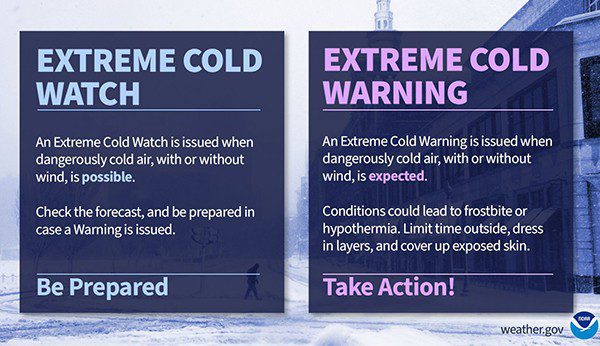picture courtesy of weather.gov
Press Release from the City of Galesburg
The National Weather Service (NWS) is predicting bitter
cold for our region beginning Tuesday, February 18th and lasting through Friday, February 21st
with wind chills as low as five to 20 degrees below zero.
The following locations in Galesburg and Knox County will be available as warming centers:
Knox County Housing Authority Overnight Shelter – 525/527 Iowa Ct, Galesburg (open
daily from 6pm – 7am)
- Public Safety Building Lobby – 150 S Broad St, Galesburg (open 24hrs, daily)
- YMCA Lobby – 1324 W Carl Sandburg Dr, Galesburg (available as a warming center on
Tuesday, 2/18 – 2/21 from 5am – 9pm) - Oneida Fire Station – 210 N Sage St, Oneida (open 24hrs, 2/18 – 2/21)
- Wataga Fire Station – 310 W Willard St, Wataga (open 24hrs, 2/18 – 2/21)
Cold Weather Safety Information
The combination of wind and low temperatures in winter can be deadly. The wind chill index
helps determine when dangerous conditions develop that could lead to frostbite or hypothermia.
It takes into account heat loss from the human body to its surroundings during cold and windy
weather. Wind chill values near minus 25 degrees indicate that frostbite is possible within 15
minutes.
Frostbite is the freezing of skin and the body tissue just beneath it. It first affects exposed body
tissue where blood circulation may be limited such as your fingers, toes, nose, and ears. To
minimize frostbite, make sure all body parts are well covered. When frostbite starts, feeling is
lost in the affected area and the frozen tissue will take on a white or pale appearance. If you
suspect you are experiencing frostbite, hold the frostbitten area closely against warm skin to
return blood flow and warmth to the affected area.
Hypothermia is a dangerously low body temperature and is the most common winter weather
killer. When you hear of a hiker, climber, hunter, or stranded traveler perishing from cold
weather exposure, hypothermia is the cause. Most people are surprised to learn that
hypothermia deaths can occur with temperatures between 30 and 50 degrees. If you or your
clothing are wet, hypothermia becomes even more of a threat. Warning signs of hypothermia
include uncontrollable shivering, memory loss, disorientation, slurred speech, and drowsiness.
Seek medical attention immediately for victims suspected of suffering from hypothermia. If no
help is available, the victim should be warmed slowly with warm liquids along with dry clothing
and blankets.
The National Weather Service issues wind chill advisories/warnings when a deadly combination
of wind and cold air is forecast. To learn more about wind chill, visit the National Weather
Service website https://www.weather.gov/ama/windchill.
- When cold weather threatens, follow these tips for survival:
- Stay dry – Wet clothing results in much faster heat loss from your body. Wear waterproof
insulated boots. - Stay covered – Wear mittens or gloves and a hat. At least half of your body heat is lost if
your head is not covered. - Dress in layers – Trapped air between loose-fitting clothing helps to insulate.
- Stay informed – Have a portable NOAA weather radio nearby to keep you up-to-date with
the latest forecasts and warnings. Use wind chill temperatures to guide you in dressing
properly for the outdoors. On very cold days, minimize your exposure to the outdoors if
possible.
Tips for Extreme Cold Weather: - Stay indoors during the worst part of the extreme cold.
- Stay home! If you MUST go out, keep a winter survival kit in your vehicle
- Check tire pressure, antifreeze levels, heater/defroster, etc.
- Learn how to shut off water valves for potential pipe bursts.
- Check on the elderly.
- Bring pets inside.
How Should I Dress? - Wear layers of loose-fitting, lightweight, warm clothing, and a hat.
- Mittens, snug at the wrist, are better than gloves.
- Cover your mouth to protect your lungs from extreme cold.
- Try to stay dry and out of the wind.








